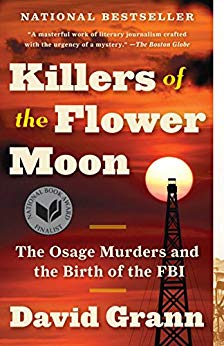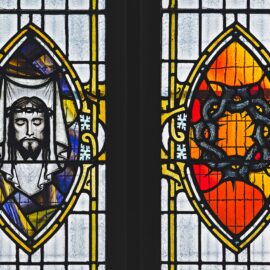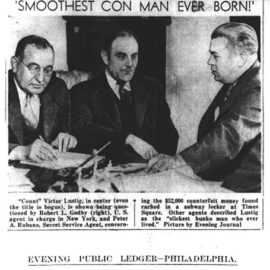

This article is an excerpt from the Shortform summary of "Killers of the Flower Moon" by David Grann. Shortform has the world's best summaries of books you should be reading.
Like this article? Sign up for a free trial here .
Who was Mollie Burkhart? What did she have to do with the Osage murders?
Mollie Burkhart was an Osage woman who was married to Ernest Burkhart. Burkhart was convicted of the Osage conspiracy, including the murder of Mollie’s sister. Mollie Burkhart suffered immensely during the Reign of Terror, and she narrowly escaped death herself.
Continue reading to learn Mollie Burkhart’s story.
The Murder of Mollie Burkhart’s Sister
On May 27, 1921, the partially decomposed body of a 25-year-old Osage woman named Anna Brown was discovered in a ravine in Osage County, Oklahoma, dead from a bullet to the back of the head. Anna would be merely one of the first victims in a five-year-long Reign of Terror that would run from 1921-1926 and claim the lives of dozens (and possibly hundreds) of Osage men, women, and children.
Anna’s immediate family included her sisters, Mollie Burkhart and Rita Smith, and her mother, Elizabeth Kyle. Mollie Burkhart was married to a white man named Ernest Burkhardt, a native of Texas who had moved to Osage County as a young man. Rita and Anna had also married white men.
(Shortform note: In this NPR interview, Killers of the Flower Moon author David Grann explains that intermarriage between whites and Osage had become quite common by the early 20th century. Many white people from states bordering Oklahoma had been drawn to the area by the oil boom and the opportunity to get rich—by either striking oil or marrying an Osage.)
Anna had been a vivacious, outgoing young woman. In the days before her disappearance, Anna’s family had been concerned about her behavior—she had been staying out late at night at speakeasies, often in the company of Bryan Burkhart, the brother of her sister Mollie’s husband. Anna had been missing for three days, immediately sparking her family’s worst fears. They were no strangers to loss—just a few years before, a younger sister named Minnie had died of a mysterious and unexplained wasting illness.
Mollie Burkhart, Ernest Burkhart, & William Hale
Because she spoke English and was married to a white man, Mollie Burkhart became the family’s natural liaison with the white authorities. But this was also due to the fact that she wasn’t married to just any white man. Her husband, Ernest Burkhart, was the nephew of William Hale, one of the most prominent figures in Osage County.
Hale was a widely respected businessman and influential force in the county, having made his fortune in the cattle business. Known as the “King of the Osage Hills,” Hale’s business interests were firmly entrenched throughout the county. He had powerful political connections and was even a reserve deputy sheriff in the town of Fairfax. The county prosecutor himself owed his election to Hale.
In an era when many white authority figures used their status to exploit and abuse the Osage, Hale positioned himself as a benevolent, if somewhat paternal, figure. His philanthropy had supported the establishment of charities, schools, and hospitals for the Osage, and he vowed to Mollie Burkhart and her mother that he would see justice done for Anna.
The Murder of Rita and Bill Smith
In March 1923, Rita and Bill Smith (the sister and brother-in-law, respectively, of Mollie Burkhart) were killed when their house went up in an explosion.
In the wake of the Smith bombing, Mollie Burkhart’s situation became even more fraught. Mollie was convinced that there was a well-orchestrated plot afoot to eliminate her family and that she would be the next target. She became a recluse, shuttering her windows and closing her home to guests. In this state of absolute terror, she even gave her new baby, Anna, to a relative to raise. Most troublingly, she was in ill health—she was a diabetic, and her condition appeared to be getting worse.
In response, the ever-present local doctors, the brothers David and James Shoun, visited Mollie Burkhart regularly to give her injections of what they claimed was insulin. But the authorities weren’t so sure that Mollie was really sick. An anonymous letter to the Bureau of Indian Affairs warned that Mollie’s life was in grave danger. Mollie wasn’t sick with diabetes—like George Bigheart, William Stepson, and her own mother, she was being poisoned. The only question was who was responsible.
Tom White’s Investigation
Tom White was sent by the FBI to investigate the crimes. Despite the political and social roadblocks, White and his team were undaunted. Through a combination of undercover sleuthing, combing through financial records, and extracting confessions from key witnesses, the agents identified the businessman, power broker, and self-styled “True Friend of the Osage” William Hale as the mastermind behind the Reign of Terror.
Hale had powerful business and political connections and supported the establishment of charities, schools, and hospitals for the Osage. Hale was more than just any local grandee, moreover—he was the uncle of Ernest Burkhart, Mollie Burkhart’s husband. He had been at Anna Brown’s funeral and even vowed to the family that he would seek justice for Anna.
The Bureau agents discovered that Ernest Burkhart and his brother, Bryan, had been willing and active accomplices in their uncle’s murderous conspiracy—Ernest Burkhart had been a party to the murder of his wife’s sisters. In piecing together the puzzle, White’s team saw that the motive for all the murders was simple: profit.
While individual Osage had been barred by the Tribal Council from buying or selling headrights, they could be inherited. An Osage who suffered many deaths in their family could find themselves with title to multiple headrights. As White studied the probate records dealing with the estates of murdered Osage, the outline of the murderous plot began to make sense.
Many of the headrights of the victims had been willed to Mollie Burkhart. When all of this money came to Mollie, it would be easy for Hale to exercise control of it through his easily manipulated nephew Ernest—though it would be even easier if Mollie were to be killed, too. This was why Mollie Burkhart’s family was being systematically eliminated. Through oil headrights and life insurance policies, Hale and his conspirators had a direct financial stake in the deaths of many Osage.
As he studied the probate records, Tom discovered that many headrights had come into the possession of Mollie Burkhart, married to Ernest Burkhart, nephew of William Hale. Ernest was known to be highly influenced by his domineering uncle. When all of this money came to Mollie, it would be easy for Hale to exercise control of it through his nephew—though it would be even easier if Mollie were to be killed, too.
This explained the precise pattern and order of deaths in Mollie Burkhart’s family. The divorced and childless Anna had been the first to be eliminated, with her headright going to her mother Lizzie. Killing Anna first ensured that her assets would not be divided up between multiple heirs. Lizzie herself was the next target, having willed her headrights to Mollie and Rita, her surviving daughters. This also explained why the next victims, Bill and Rita Smith, had died in a bombing attack, which was an unusual method of killing. In fact, the Smith murders were done this way because it was critical that the two died at the same time. If only Rita had died, her headrights would have gone to her husband Bill Smith. But because the couple died mere days apart, Rita’s headright reverted to her only surviving heir—Mollie Burkhart. It all began to make sense as the outlines of the murderous plot became clear to Tom White. By conspiring to have all the members of Mollie’s family killed, Hale was maneuvering to have all their headrights bequeathed to her. Once Mollie Burkhart herself was murdered, the oil wealth would be his to exploit.
The Trial of Ernest Burkhart
The trial was devastating for Mollie Burkhart, as she learned more about the plot to eliminate her family. The national press, which avidly covered the case, refused to respect her privacy, circulating photos of her around the country and generally portraying her as an ignorant, backwoods Osage. Hale, meanwhile, packed the gallery with his supporters, who would hoot and cheer at every motion made by the defense and jeer and boo the prosecution. It brought a circus-like atmosphere to the trial and amply demonstrated the difficulties of bringing a white man to justice for crimes against an Osage Indian.
During the trial, Hale’s team lied and blatantly tampered with the witness Ernest Burkhart and attempted to intimidate him into silence. Shockingly, the judge allowed all of this to happen in open court. On one occasion, Hale openly berated Burkhart personally, in full view of the judge and jury. Tom White was outraged and appalled by the utter brazenness and arrogance of Hale’s conduct.
Now, under the pressure of Hale’s backroom scheming, Ernest recanted his testimony, claiming that he knew nothing about the murders and taking the stand as a witness for the defense instead of the prosecution. Outrageously, he claimed that Tom White’s agents had only obtained his confession through torture—a lie that was echoed by Hale and Ramsey. White’s one-time star witness was being used against him.
Although J. Edgar Hoover back in Washington knew these charges against the Bureau to be totally baseless, he was fearful of anything that might bring further embarrassment or scandal to the Bureau. Behind the scenes, there was mounting political pressure to sack White and his team.
To bolster their position against Hale, the prosecution decided to first seek a conviction of Ernest Burkhart. With Ernest recanting, however, their case looked like it was falling apart. But the prosecution had one more card to play: Kelsie Morrison, the notorious bootlegger, outlaw, onetime Bureau informant, and the man whom Ernest had fingered as Anna Brown’s killer. The prosecutor brought Morrison in to take the stand. This time, Morrison decided to cooperate with the government against his former employer, Hale. Morrison confessed in open court that he had been recruited by Hale to help eliminate Mollie Burkhart’s entire family. He then proceeded to narrate the awful details of Anna’s final moments.
On October 29, 1926, both Hale and Ramsey were found guilty of first-degree murder and sentenced to life imprisonment. Neither man made any statement upon the conviction and sentencing. The next year, Morrison was convicted of Anna’s murder, although Bryan Burkhart was ultimately given immunity by the prosecution.
In response to the murders, the Osage Tribal Council persuaded Congress to pass a law barring anyone who was not at least half-Osage from inheriting a headright, removing some of the incentives for whites to murder them. Mollie Burkhart divorced Ernest shortly after he was sent to prison, revolted and outraged by what he and his family had done. Treacherously, many of the co-conspirators—including Bryan and Ernest Burkhart, Morrison, and Hale—had been among the crowd of onlookers when Anna’s body was discovered, comforting Mollie in her hour of need. Little did Mollie know that she was being comforted by blood-stained hands.

———End of Preview———
Like what you just read? Read the rest of the world's best summary of David Grann's "Killers of the Flower Moon" at Shortform .
Here's what you'll find in our full Killers of the Flower Moon summary :
- How the Osage tribe had vast oil wealth, but had it seized by their murderous neighbors
- The brutal and unresolved murders of Osage Native Americans
- The complicated history of the FBI in profiting from the Osage murders






